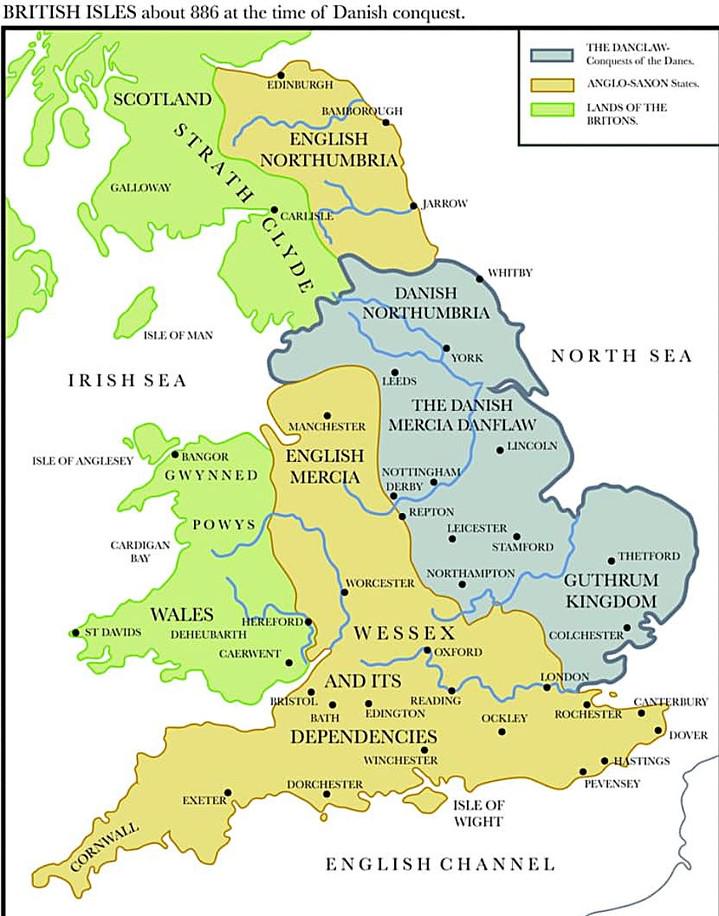Danelaw Map of Viking England (865–954)


Alex Cartwright
Senior Cartographer & GIS Specialist
Alex Cartwright is a renowned cartographer and geographic information systems specialist with over 15 years of experience in spatial analysis and data...
Geographic Analysis
What This Map Shows
The visualization titled "When Vikings Ruled Part of England: The Danelaw (865–954)" illustrates the geographical extent of the Danelaw, a significant political and cultural region established by the Vikings during their invasions of England. This map outlines the territories where Norse law and customs prevailed, highlighting the areas that were influenced or directly controlled by Viking settlers. The Danelaw covered much of what is now northern and eastern England, including key towns that served as centers of Viking activity.
Deep Dive into the Danelaw
The Danelaw was not just a geographical territory; it represented a fusion of cultures and legal practices that significantly shaped English history. Established in the late 9th century, it emerged from a series of invasions and settlements by the Norse peoples, particularly the Danes. Interestingly, the term "Danelaw" itself refers to the laws that governed this region, which differed markedly from those in the Anglo-Saxon territories.
The map reveals how the Danelaw was primarily located in regions that are now Yorkshire, Lincolnshire, and East Anglia. This area was characterized by a blend of Anglo-Saxon and Norse cultures, leading to unique developments in language, trade, and governance. For example, many place names in these areas still retain Norse origins, reflecting the deep-rooted influence of Viking settlers. Have you ever wondered why so many towns in this region end with the suffix '-by'? It’s derived from the Norse word for "town" or "village."
What's fascinating is that the Danelaw was marked not just by Viking warriors but also by their farmers, artisans, and traders. The Vikings brought with them advanced agricultural practices and new trade routes that connected England with other parts of Scandinavia and beyond. This led to a flourishing economy in the Danelaw, with towns like York (Jorvik) becoming vibrant centers of commerce.
Overall, the Danelaw played a crucial role in shaping modern England. Its influence extended into the legal systems, with some Viking laws merging with Anglo-Saxon traditions to form a unique blend that persisted long after the Viking Age had ended. The Danelaw's legacy can still be felt today, evidenced by the rich cultural tapestry of the regions it once encompassed.
Regional Analysis
Examining the Danelaw map in detail allows us to understand regional variations in Viking influence. For instance, the northern regions, particularly around York, were heavily fortified and became significant administrative centers. York was not only a military stronghold but also a cultural hub, where Norse and Anglo-Saxon traditions intertwined. This area is known for its archaeological finds, including remnants of Viking longhouses and artifacts that signify a thriving settlement.
In contrast, East Anglia, while also part of the Danelaw, had a more agrarian focus. The fertile lands supported robust farming communities, which allowed for a different kind of Viking settlement compared to the more urbanized areas. Here, Viking farmers established homesteads that contributed to the agricultural output of the region. The juxtaposition of urban centers like York and rural areas in East Anglia highlights the multifaceted nature of Viking settlement patterns.
Interestingly, the influence of the Danelaw didn't just fade away with the end of Viking rule. The mixing of cultures led to significant changes in social structures, language, and even religious practices in England. The Norse gods and myths began to blend with local beliefs, creating a rich tapestry of folklore that persists in English culture today.
Significance and Impact
Understanding the Danelaw and its geographical implications is crucial for grasping the historical context of England. The Viking Age was a transformative period that reshaped not only the landscape of England but also its cultural identity. The Danelaw serves as a reminder of how invasions and migrations can lead to significant societal changes.
Moreover, the legacy of the Danelaw is evident in modern discussions about cultural identity and heritage in England. As we look at current trends, such as the revival of interest in Viking history and culture, it’s clear that the impacts of this era are still felt. Today, heritage tourism in areas that were once part of the Danelaw attracts visitors eager to learn about the Viking legacy.
As we delve into the past through historical maps like this one, we gain valuable insights into how geographical boundaries can define cultural experiences. The Danelaw was not merely a region; it was a defining chapter in the story of England, one that continues to resonate through time.
Visualization Details
- Published
- October 21, 2025
- Views
- 24
Comments
Loading comments...